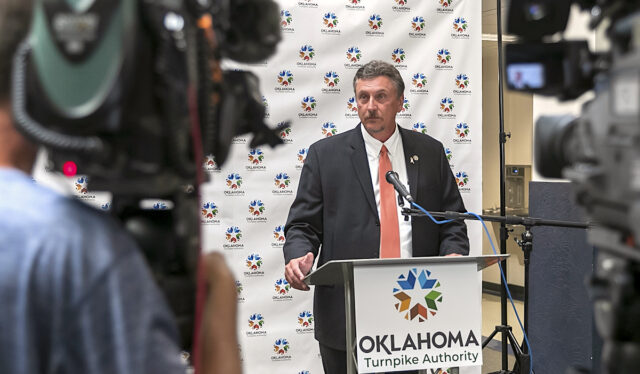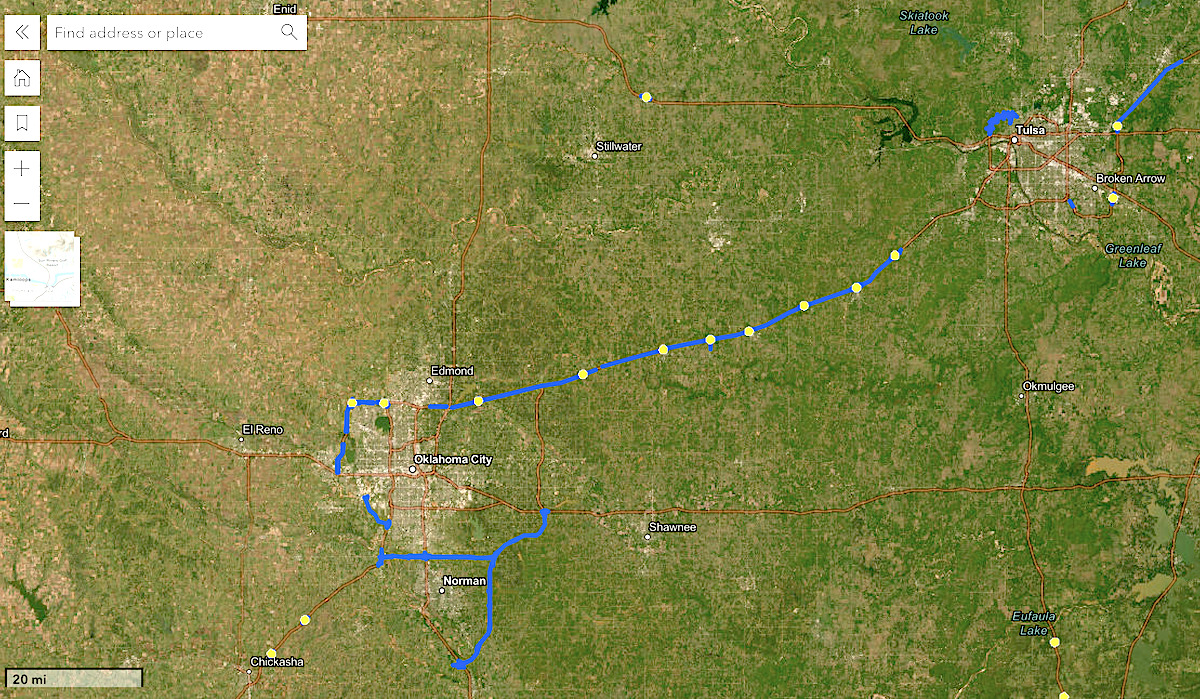

The Oklahoma Turnpike Authority has received approval to take out loans to finance new toll roads that were challenged by the City of Norman and area residents who stand to lose their homes to the expansion.
In a 6-3 decision Tuesday, the Oklahoma Supreme Court approved a request by OTA to validate $500 million in bonds for ACCESS Oklahoma, a process that is required before bonds can be sold to pay for the projects. ACCESS stands for Advancing and Connecting Communities and Economies Safely Statewide, and Gov. Kevin Stitt announced the project in February 2022 as a $5 billion, 15-year planning effort that will expand the Will Rogers Turnpike and much of the John Kilpatrick Turnpike to six lanes, while adding new connector loops in the Oklahoma City and Norman metro areas.
“The OTA has properly exercised its authority to determine the route for the south extension,” wrote Justice James Winchester. “Further, the OTA has legislative authority (…) to issue additional bonds to finalize the loop. Accordingly, we approve the revenue bonds.”
In dissenting, Vice Chief Justice Dustin Rowe countered that the majority’s decision confers upon the OTA “incredibly broad discretion without any cognizable limits.”
“The OTA is apparently free to blatantly disregard the Legislature’s directives with respect to routes and funding,” Rowe wrote. “This decision does not simply approve the proposed bonds, it sets a new precedent that future bond applications seeking our approval are merely seeking our rubber stamp — which we freely give today.”
Secretary of Transportation Tim Gatz, who also serves as OTA’s executive director, said it may be several years before actual construction begins on the project’s controversial south extension, which would divert Interstate 35 traffic east around Norman and Oklahoma City with a connection near Purcell.
“To be clear, we are at the very beginning stage of this long-range plan,” Gatz said during a press conference at Oklahoma Department of Transportation headquarters. “Construction in the Norman area specifically likely will be several years away from today. However, we will assist [residents] to the best of our ability with the information that we have available and continue to work diligently.”
Gatz encouraged property owners with questions to contact OTA through its toll-free number, 1-844-562-2237, email info@accessoklahoma.com or visit OTA’s Oklahoma Access webpage, ACCESSoklahoma.com.
“We’ll continue to do everything that we can to work with property owners that are potentially impacted to make sure that they have the information available to them that they’re going to need to make good decisions, and we’ll do everything we can to work with them,” he said. “That holds true today just as it did in the beginning.”
Gatz said he does not know how many homeowners may be displaced by the new turnpikes.
“Until you have established right-of-way lines, you really don’t have a true reflection of how many property owners may be affected,” he said. “A lot of times you’re going to have differing needs among the property owners. Some will want to stay as long as they can, others may want to go ahead and move forward with a right-of-way transaction.”
‘It’s not just losing our homes’

Opposition has focused mostly on the ACCESS Oklahoma project’s south extension, which would run south from Interstate 40 near Newalla around Norman and into McClain County for the Interstate 35 connection just north of Purcell. While proponents say the extension will be critical to divert commercial truck traffic and other travelers around the OKC metro, opponents claim the turnpike expansion would eliminate more than 600 homes.
Lawsuits filed by members of Pike Off, a grassroots opposition group, claim OTA was vague on early agreements related to ACCESS Oklahoma and violated the Open Meeting Act. The Supreme Court in May overruled a district judge who had found in December that the OTA had violated the Open Meeting Act.
Tassie Katherine Hirschfeld, a volunteer with the grassroots organization Oklahomans for Responsible Transportation and one of the property owners whose home is in the proposed route of the southern turnpike loop, said members of the group will discuss with their attorneys whether to seek a rehearing. They have 20 days to file a petition seeking one.
“It’s not just losing our homes,” she said. “It’s giving up democracy because there’s no property rights, there’s this autocratic court.”
Randy Carter, with Oklahomans for Responsible Transportation, said he was disappointed with the Supreme Court’s ruling. He built his house 20 years ago, and its living room is in the middle of the proposed southern extension.
“It will take some wind out of our sails temporarily,” he said of Tuesday’s ruling.
Robert Norman, an OKC attorney representing the group Pike Off OTA, said that group will continue its fight.
“The dissenting opinions provided a convincing, well-reasoned explanation of why the new turnpikes clearly exceed the critically important guardrails the Legislature has placed upon the Turnpike Authority,” he said in a statement. “Justice Rowe convincingly pointed out the dangers of today’s decision. It essentially gives the OTA incredibly broad powers without known limits, and the OTA now appears to be free to blatantly disregard the people’s elected representatives.”
“We will continue our fight to vindicate the rule of law, our cherished civil rights, and representative democracy,” he said. “We must return our government to the people. We must never yield to the rule of a few unelected bureaucrats and narrow special interests who seek to exercise unlimited power at the expense of all of us.”
‘This restart will take place over the coming months’

Work on ACCESS Oklahoma was halted in April as the Turnpike Authority faced ongoing lawsuits, uncertainty over the bond validation, and a request by Attorney General Gentner Drummond for a first-ever investigative audit of OTA operations and actions related to ACCESS Oklahoma.
“Restarting the engineering work will take months,” Gatz said. “It’s not something that will be immediate. (…) This restart will take place over the coming months.”
Now that the Supreme Court has validated the bonds, OTA will resubmit its application to the Oklahoma Council of Bond Oversight and will resume discussions with the Bureau of Reclamation to reapply or adjust the alignment of the south extension turnpike project, Gatz said.
In its Jan. 17 notice to OTA, the federal Bureau of Reclamation said it denied the Turnpike Authority’s request for perpetual use authorization for turnpike construction across east-Norman fee title land — near Lake Thunderbird — because the proposed project is not compatible with congressionally authorized purposes for which the land was acquired and is still needed.
“However, Reclamation does not object to OTA routing the turnpike across Norman project pipeline and flowage easements if the easement crossings are planned, designed, and constructed such that the turnpike does not interfere with Reclamation’s easement interests or impact operation, maintenance, and replacement of Norman project infrastructure,” the notice stated. “Such easement crossings would require close coordination with Reclamation through planning, design, and construction process.”
The $500 million in revenue bonds would fund the initial work of the 15-year, $5 billion ACCESS Oklahoma long-range plan. That work includes funding for studies and engineering design of three proposed new route alignments in the Oklahoma City metro area that will complete the “outer loop” first envisioned by lawmakers and state leaders three decades ago. The funding also would jump start construction projects in the long-range plan, including widening both the John Kilpatrick Turnpike and the Interstate 44/Turner Turnpike to six lanes, adding interchanges along many existing toll routes to connect communities, and making other safety upgrades across the system.
In its petitions with the Supreme Court, the OTA said that, in 1993, the Oklahoma Legislature added a new turnpike project authorization: “A new turnpike and bridge or any parts thereof from a point in the vicinity of the city of Mustang southerly across the South Canadian River to the H.E. Bailey Turnpike in the vicinity of the city of Tuttle; and then easterly across the South Canadian River to a point in the vicinity of the city of Norman.”
It is common for an initial turnpike route to change because of unforeseen circumstances, OTA attorneys said in earlier court filings.
Winchester, in writing for the majority, said the high court should not “inject itself into the route-making process for a new turnpike location in the vicinity of Norman.”
“For over 30 years, the Legislature has given the OTA discretion to select turnpike routes within the locations authorized by the Legislature,” he wrote. “The court has consistently honored the discretion given to the OTA by the Legislature and allowed the OTA to exercise its judgment as the OTA has the engineering expertise and traffic data to make these complex far-reaching decisions regarding turnpike routes. We uphold the authority given to the OTA to decide routes for turnpikes and conclude that the OTA has the legislative authority to construct the south extension.
“To hold otherwise would inject this court into the OTA’s decision-making process regarding turnpike routes. The OTA contends the proposed components of the loop and south extension will meet the purposes of the OTA to better facilitate vehicular traffic and meet safety needs, as traffic counts have steadily increased for the last three decades.”
Opponents argued that the OTA’s proposed route in the Norman area deviated from routes approved by the Legislature. But Winchester said the Legislature gave the OTA “very broad authority” to determine routes, including access and connecting roads.
“As previously held by this court, we refuse to strictly construe these legislative authorizations and instead defer to the OTA’s technical expertise in determining routes,” he wrote.
The state’s Council of Bond Oversight last August approved the $500 million in revenue bonds with the condition that lawsuits against the Norman-area toll roads were resolved first. COBO’s approval was good for 180 days, meaning it expired Feb. 2.
On May 31, the Oklahoma Supreme Court ruled in a 5-3 decision that OTA did not violate the state’s open meeting law. It overturned a lower court ruling that stated OTA officials willfully violated the Open Meeting Act when they unveiled the ACCESS Oklahoma toll road plan.
A group of residents and landowners claimed they would be adversely affected by the construction of one of the proposed new turnpikes — the south extension — and filed a lawsuit in Cleveland County District Court claiming the OTA violated the Open Meeting Act.
They alleged the OTA violated the Open Meeting Act by not providing sufficient nor timely notice of the new proposed turnpikes in either its January 2022 or February 2022 agendas. They also challenged the lack of notice in the Feb. 22, 2022, meeting agenda of Gov. Kevin Stitt’s announcement of the ACCESS Oklahoma program.
The Open Meeting Act requires that agendas contain subjects to be discussed in meetings and that agendas be provided to the public in advance of meetings.
Read the Supreme Court ruling here
